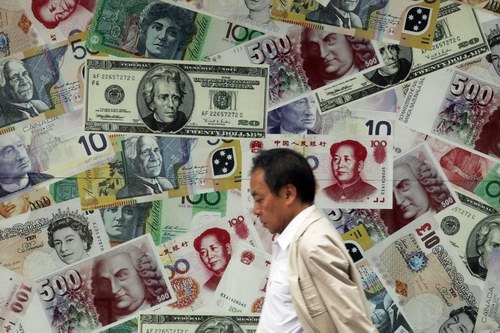Economy
Offshore financial assets expand 7% to $4.4t
Updated: 2011-07-27 08:56
By Gao Changxin (China Daily)
SHANGHAI - China's offshore financial assets rose 7 percent in the year to March to $4.4 trillion, primarily propelled by rising foreign-exchange reserves.
According to the nation's balance sheet of foreign-exchange assets and liabilities, also known as the International Investment Position, offshore financial liabilities increased 5 percent to $2.5 trillion as of the end of March. That resulted in net assets of $1.9 trillion, according to a statement on the website of the State Administration of Foreign Exchange (SAFE) on Tuesday.
 |
|
An advertisement for exchange services for China's renminbi, or yuan, the US dollar and the euro at a money exchange in Hong Kong. [Photo/Agencies] |
It was the first time that SAFE, manager of China's $3.2 trillion in foreign reserves, updated the figures on a quarterly basis. Previously, the balance sheet was only released annually.
"China's overseas financial assets and liabilities have increased constantly over the past few years, boosted by increased foreign-exchange reserves and overseas investment," said Lu Zhengwei, chief economist with Industrial Bank Co Ltd.
"It is a result of China's increased forays into international markets." The International Investment Position reflects a country's stock of financial assets and liabilities to outside nations. Combined with the balance of international payments, it shows a country's complete international trade and investment flows.
China's current-account surplus - the broadest measure of trade with the world - narrowed 21 percent to $28.8 billion in the first quarter, according to SAFE's revised figures published in May.
The capital-account surplus, which measures the net capital inflow, widened 41 percent from a year earlier to $86.1 billion during the same period.
Reserve assets, including foreign-exchange reserves, gold and special drawing rights, remained the biggest portion of the $4.4 trillion in financial assets, or 71 percent, unchanged from the end of 2010.
Reserve assets increased $201.4 billion in the first quarter, including $197.3 billion in foreign exchange reserves, to $3.1 trillion.
"Foreign-exchange reserves are still the main channel through which China's overseas financial assets increase," said Ding Zhijie, dean of the School of Banking and Finance at the Beijing-based University of International Business and Economics.
China's foreign reserves, now the world's biggest, have surged in recent years, supported by long-term capital- and current-account surpluses.
Ding added that judging from SAFE's figures, the country has done a good job in investing its foreign reserves in the first quarter.
Out of the $197.3-billion increase in foreign reserves in the first quarter, $138 billion was generated from net capital inflows, Ding said.

Specials

Turning up the heat
Traditional Chinese medicine using moxa, or mugwort herb, is once again becoming fashionable

Ciao, Yao
Yao Ming announced his retirement from basketball, staging an emotional end to a glorious career.

Financial sector short of talent
Lack of skilled professionals in Shanghai inhibiting the city's development as a financial hub